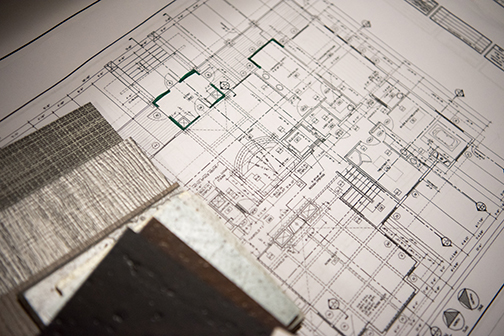Interior Design Major
A professional interior designer is one who is qualified by education, examination, and experience to identify, research and creatively solve problems relative to the function and quality of people's interior environments. The course of study in interior design leads to a first professional degree.
Students pursue courses in which creative and technical skills are applied within a structure to achieve the built interior environment. Design solutions are functional, enhance the quality of life of occupants, and are aesthetically pleasing while adhering to code and regulatory information. Design solutions produce, protect, and enhance the health, safety and welfare of the public. Students learn how to approach design problems through a methodology that includes data gathering, product specification, identification of details, contractual documents, and design business procedures.
The first two years of the program introduces the fundamentals of design, visual and technical communication techniques (including drafting, CADD, perspective drawing, model building, 3D modeling, and rendering), and theoretical and practical applications (including anthropometrics, ergonomics, interior design technology, interior materials, and color theory). The interior design profession is exceedingly complex, and collaborating with design professionals and related disciplines in a team approach to problem solving is routine practice. Beginning their first year through their final semester, students interact with professionals during industry tours, critiques, and guest speaking events providing a direct connection to the interior design profession.
Upper-division course work is focused on a series of integrated studio experiences and supports courses including history, professional practice, building information modeling, and interior systems. The studio experience culminates in a capstone project. Studio experiences require that each student be exposed to a variety of projects at several different levels of complexity and different client project goals.
NDSU interior design students are required to complete a field experience between the third and fourth year of the program. Students accept a variety of positions throughout the United States. In the past few years students have completed field experiences in cities such as Los Angeles, Minneapolis, Denver, Florida, New York, Ireland, and Shanghai (China).
Laptop computers are required equipment for all first-year students beginning the spring semester. These computers need to be built to operate industry specific programs. Refer to the interior design program website for computer specifications.
Admission into second-year interior design courses requires a 3.0 institutional minimum cumulative grade-point average and a minimum grade of 'C' in all major core requirements. Admission into the second-year of the interior design program is also based on the review of a completed application and letter of intent that demonstrates professional and academic interest. This is submitted during the spring semester of the student's first year in the interior design program. Students must maintain the 3.0 institutional minimum cumulative GPA and earn a grade of 'C' or better in all major core requirements throughout the remainder of the program. Transfer students entering the interior design program should contact the program coordinator to review previously completed interior design or related course work.
The interior design program at NDSU is accredited by the Council for Interior Design Accreditation and the National Association of Schools of Art and Design.
Plan of Study
IMPORTANT DISCLAIMER: This guide is not an official curriculum. This guide is a sample four-year degree plan of how students might plan this major with other degree requirements to complete their education in four years.Student plans will vary from this sample due to a variety of factors, such as, but not limited to, start year, education goals, transfer credit, and course availability. To ensure proper degree completion, enrolled students should utilize Degree Map and Schedule Planner in Campus Connection and consult regularly with academic advisors to ensure graduation requirements are being met.
| Freshman |
|---|
| Fall | Credits | Spring | Credits | |
|---|
| ADHM 151 | 3 | ADHM 162 | 3 | |
| ADHM 160 | 1 | ADHM 261 | 3 | |
| ADHM 161 | 3 | COMM 110 | 3 | |
| ENGL 110 | 4 | ENGL 120 | 3 | |
| Social/Behavioral Science | 3 | Quantitative Reasoning | 3 | |
| Wellness | 2 | | |
| | 16 | | 15 |
| Sophomore |
|---|
| Fall | Credits | Spring | Credits | |
|---|
| ADHM 251 | 3 | ADHM 253 | 3 | |
| ADHM 264 | 2 | ADHM 363 | 3 | |
| ADHM 365 | 3 | ADHM 368 | 2 | |
| ART 111, 210, or 211 | 3 | ADHM 491 | 1 | |
| Science/Tech w/Lab | 4 | CSCI 114 or MIS 116 | 3 | |
| | Science/Tech | 3 | |
| | 15 | | 15 |
| Junior |
|---|
| Fall | Credits | Spring | Credits | Summer | Credits |
|---|
| ADHM 300 | 1 | ADHM 316 | 3 | ADHM 496 | 3 |
| ADHM 315 | 3 | ADHM 353 | 3 | |
| ADHM 351 | 3 | HD&E 320 | 1 | |
| ADHM 460 | 3 | Social/Behavioral Sci | 3 | |
| ADHM 461 | 3 | Minor Course | 3 | |
| Minor Course | 3 | Minor Course | 3 | |
| | 16 | | 16 | | 3 |
| Senior |
|---|
| Fall | Credits | Spring | Credits | |
|---|
ADHM 366
& ADHM 367 | 4 | ADHM 452 | 6 | |
| ADHM 450 | 3 | ADHM 491 | 1 | |
| Upper Div Writing | 3 | Minor Course | 3 | |
| Minor Course | 3 | Minor Course | 3 | |
| Minor Course as needed | 3 | Minor Course as needed | 3 | |
| | 16 | | 16 |
| Total Credits: 128 |

